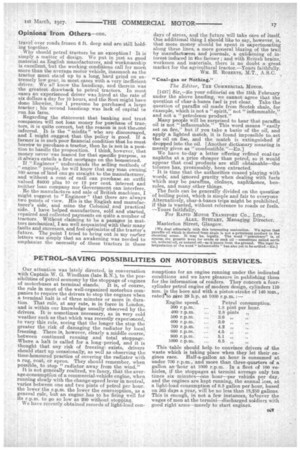PETROL.-SAVING POSSIBILITIES ON MOTORBUS SERVICES.
Page 17

If you've noticed an error in this article please click here to report it so we can fix it.
Our attention was lately directed, in conversation with Captain W. G. Windham (late R.N.), to the possibilities of petrol economy by the stoppage of engines of motorbuses at terminal stands. It is, of course, the rule in most of the well-organized motorbus companies to require the drivers to stop the engines when a terminal halt is of three minutes or more in duration. That rule, at any rate, is in force in London, and is within our knowledge usually observed by the drivers. It is sometimes necessary, as in very cold weather such 'as that which was recently experienced,' to vary this rule, seeing that the longer the stop the greater the risk of damaging the radiator by local freezing. There is, however, clearly a middle course,' between continued running and total stoppage. Where a halt is called for a long,period, and it is thought that any risk of freezing, exists, drivers should start up occasionally, as WK311 as observing the time-honoured practice of covering the radiator with a rug, coat, or apron. They should remember, when possible, to stop "radiator away from the wind." It is not generally realized, we fancy, that the average .consumption of a commercial-vehicle engine, when running slowly with the change-speed lever in neutral, varies between one and two pints of petrol per hour. the lower the r.p.m. the lower the consumption, as a general rule, but an engine has to be firing. well for its r.p.m. to go so low as 200 without stopping. We have recently obtained records of light-load con sumptions for an engine running under the indicated conditions and we have pleasure in publishing them for the information of readers. They concern a fourcylinder petrol engine of modern design, cylinders 110 mm. in the bore and with a piston-stroke of 140 mm., ratedeto give 29 h.p. a.t 1000 r.p.m. — This table should help to convince drivers of the waste which is taking place when they let their engines race. Half-a-gallon an hour is consumed at under 700 r.p.m., and more than three-quarters of a gallon an 'hour at 1000 r.p.m. In a fleet of 100 vehicles, if the stoppages at termini average only ten times six minutes—one hour—per vehicle per day, and the engines are kept running, the annual loss, at a light-load consumption of 0.5 gallon per hour, based on 365 days a year, will be no less than 18,250 gallons. This is enough, in not a few instances, togcoter the wages of men at the termini—discharged soldier with good right arms—merely to start engines.




















